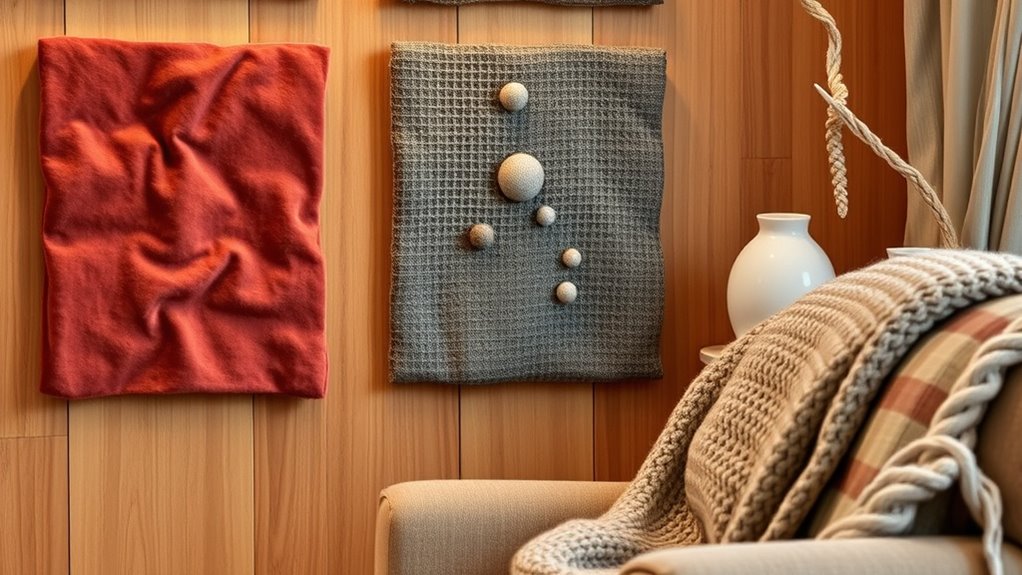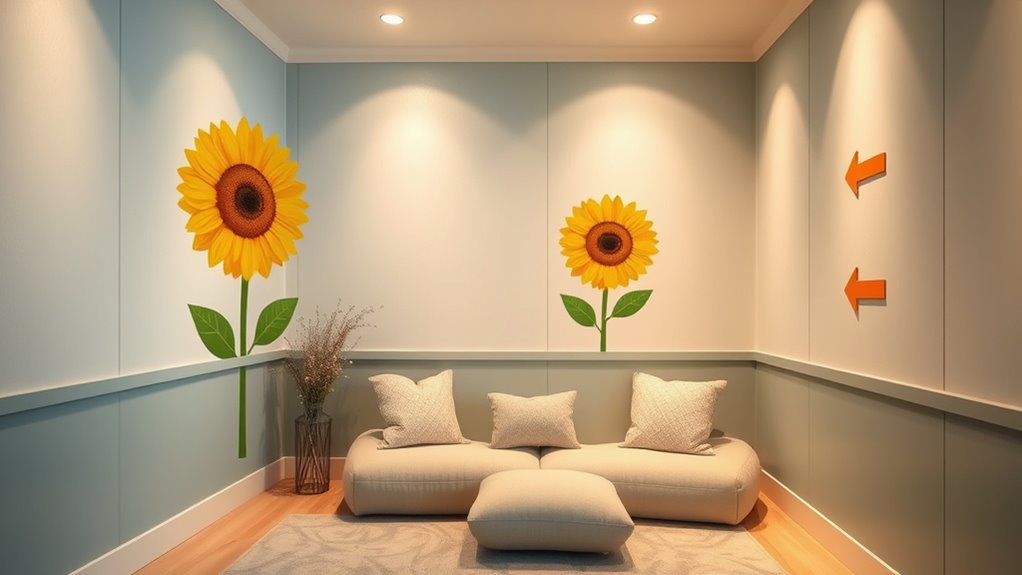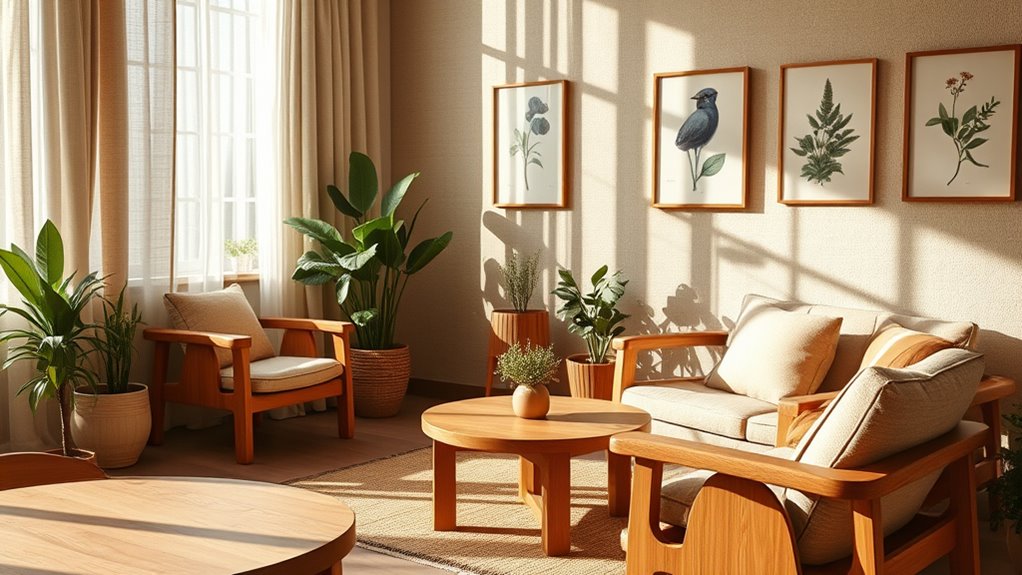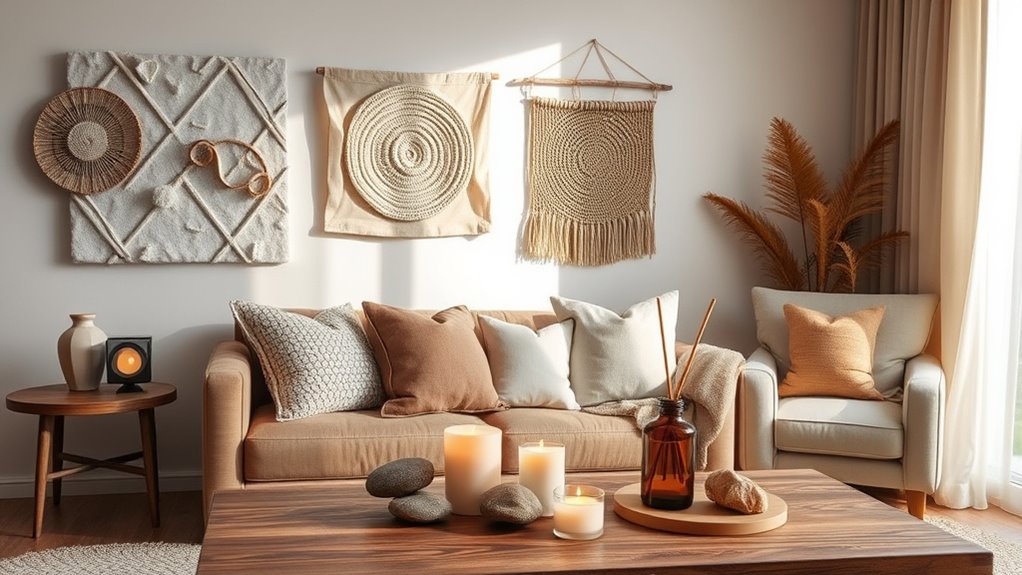To create effective sensory décor for dementia care, focus on adding textured fabrics and tactile art to stimulate touch and promote calmness. Use clear visual cues with contrasting colors for easy navigation and familiar spaces. Incorporate soothing sounds and familiar music to foster relaxation. Personalize environments with keepsakes and familiar scents to boost emotional comfort. Embrace natural materials and gentle lighting to support well-being. Explore these ideas further to craft spaces that soothe and engage.
Key Takeaways
- Incorporate textured fabrics and tactile art to stimulate touch and promote calmness.
- Use high-contrast colors and clear visual cues to aid navigation and orientation.
- Integrate soothing sounds and familiar music to create a relaxing environment.
- Personalize spaces with keepsakes, photos, and familiar scents to foster comfort and emotional connection.
- Include natural materials and soft lighting to enhance well-being and support circadian rhythms.
Incorporating Tactile Elements to Stimulate the Sense of Touch

Incorporating tactile elements into a dementia care environment can substantially enhance residents’ comfort and engagement. Using textured fabrics, such as soft blankets, plush cushions, and varied upholstery, invites residents to explore different surfaces and textures. These elements provide sensory stimulation, helping to ground residents in the present moment. Tactile art pieces, with raised patterns or textured materials, offer additional opportunities for touch-based interaction. Encouraging residents to feel and manipulate these items can reduce anxiety and promote a sense of calm. The integration of sound design techniques, such as subtle ambient sounds or gentle auditory cues, can further enrich the sensory environment and promote relaxation. By thoughtfully integrating textured fabrics and tactile art into your space, you create a warm, inviting environment that nurtures sensory awareness and provides meaningful engagement for those with dementia.
Using Visual Cues and Color Schemes for Orientation and Calm

Using strategic visual cues and thoughtfully chosen color schemes can considerably improve orientation and promote calm in dementia care environments. Visual contrast helps residents distinguish between different areas, such as doorways, staircases, or furniture, reducing confusion and risk. Incorporate color coding—assigning specific colors to particular zones or objects—to create intuitive cues that guide navigation effortlessly. For example, using a bold color on bathroom doors or hallway walls can signal different spaces clearly. Consistent use of high-contrast colors minimizes visual noise and enhances focus. By carefully selecting and applying these visual cues, you create a more supportive environment that fosters independence, reduces anxiety, and helps residents feel more secure in their surroundings.
Integrating Soothing Sounds and Music to Promote Relaxation

Integrating soothing sounds and music into dementia care environments can considerably enhance residents’ relaxation and emotional well-being. Sound therapy leverages gentle, calming sounds to reduce agitation and promote comfort. Playing soft music or nature sounds creates a peaceful atmosphere that can help residents feel more at ease. Musical engagement also encourages interaction, which boosts mood and cognitive function. You can introduce playlists with familiar tunes or calming melodies to foster a sense of familiarity and security. Using sound equipment strategically guarantees the environment remains soothing without becoming overwhelming. When incorporated thoughtfully, these auditory elements support relaxation, reduce stress, and improve overall quality of life for residents living with dementia. Sound therapy is an evidence-based approach that can be tailored to individual preferences, further enhancing its effectiveness.
Creating Familiar and Personalized Spaces for Comfort

Creating familiar and personalized spaces can considerably improve comfort for residents with dementia by helping them feel more secure and at ease. Incorporate personalized keepsakes, like family photos or cherished mementos, to evoke positive memories and foster a sense of identity. Using familiar scents, such as a favorite perfume or the smell of home-cooked meals, can also trigger comforting feelings and reduce anxiety. Keep these items within easy reach or display them in visible spots to create an environment that feels safe and welcoming. By tailoring spaces with familiar objects and scents, you help residents reconnect with their past and establish a sense of stability. This personalization not only promotes emotional well-being but also encourages engagement and a sense of belonging. Additionally, understanding the importance of wealth can help caregivers appreciate the value of creating environments that foster emotional security and stability for residents.
Utilizing Natural Materials and Lighting to Enhance Well-Being

Natural materials and lighting play a crucial role in fostering a calming environment for residents with dementia. Using natural elements like wood, stone, and textiles creates a soothing atmosphere through texture contrast, engaging residents’ senses gently. Proper lighting, especially soft, natural light, reduces confusion and enhances mood by supporting circadian rhythms. You can incorporate aromatherapy benefits by diffusing essential oils like lavender or citrus, which promote relaxation and mental clarity. These natural scents complement the tactile experience of textured materials, providing multi-sensory stimulation without overwhelming residents. Additionally, selecting vetting materials ensures safety and durability in the environment. By thoughtfully combining natural materials with appropriate lighting, you help create a space that feels safe, familiar, and supportive, ultimately enhancing residents’ well-being and quality of life.
Frequently Asked Questions
How Can Sensory Décor Reduce Agitation in Dementia Patients?
You can reduce agitation in dementia patients by creating a calming environment with sensory décor. Incorporate music therapy, which soothes and relaxes, and use aromatherapy benefits like lavender or citrus scents to promote calmness. Engaging their senses in a gentle way helps them feel secure and reduces distress. Thoughtfully designed sensory décor makes a significant difference in managing agitation, fostering comfort and tranquility for your loved ones.
What Safety Considerations Are Essential When Adding Tactile Elements?
When adding tactile elements, you need to prioritize safety. Make sure surfaces are non-slip to prevent falls, especially in high-traffic areas. Use hypoallergenic textiles to reduce skin irritation and allergies. Regularly inspect textures for wear or damage that could cause harm. Confirm all tactile items are securely attached and easy to clean, preventing potential choking hazards or bacterial buildup. Safety is key to creating a calming, secure environment for dementia patients.
How Do Color Choices Impact Mood and Memory Retention?
You should consider how color choices impact mood and memory retention through color psychology and memory cues. Bright, warm colors like yellow and orange can boost happiness and alertness, while softer tones like blue and green promote calmness. Using familiar colors as memory cues helps reinforce recognition and orientation. By thoughtfully selecting colors, you create a supportive environment that positively influences emotional well-being and cognitive function.
Which Natural Materials Are Most Beneficial for Sensory Environments?
Natural materials like soft natural fibers and organic textures create calming, engaging sensory environments. You should incorporate materials such as cotton, wool, silk, and hemp because they provide gentle tactile stimulation and promote comfort. Using these natural elements helps reduce stress and confusion, making spaces more inviting. By choosing organic textures, you enhance sensory engagement and support well-being, creating a nurturing atmosphere that’s both soothing and stimulating for those with dementia.
How Often Should Sensory Décor Be Updated or Changed?
You should update your sensory décor seasonally to keep the environment engaging and stimulating. Regular updates allow you to incorporate new elements that reflect seasonal changes, which can boost mood and familiarity. Use personalization techniques to tailor the décor to individual preferences, ensuring it remains comforting and relevant. Typically, changing décor every few months or with each season helps maintain a fresh, inviting space that supports well-being.
Conclusion
While these sensory décor ideas aim to bring comfort and clarity, don’t be surprised if your loved one still forgets where they placed their keys—yet somehow remembers the soothing sound of a favorite song. Sometimes, despite all the thoughtful touches, dementia keeps us on our toes. But by creating familiar, calming spaces, you’re giving them a gentle anchor in a world that often feels unpredictable. After all, even in confusion, a touch of familiarity can work wonders.









